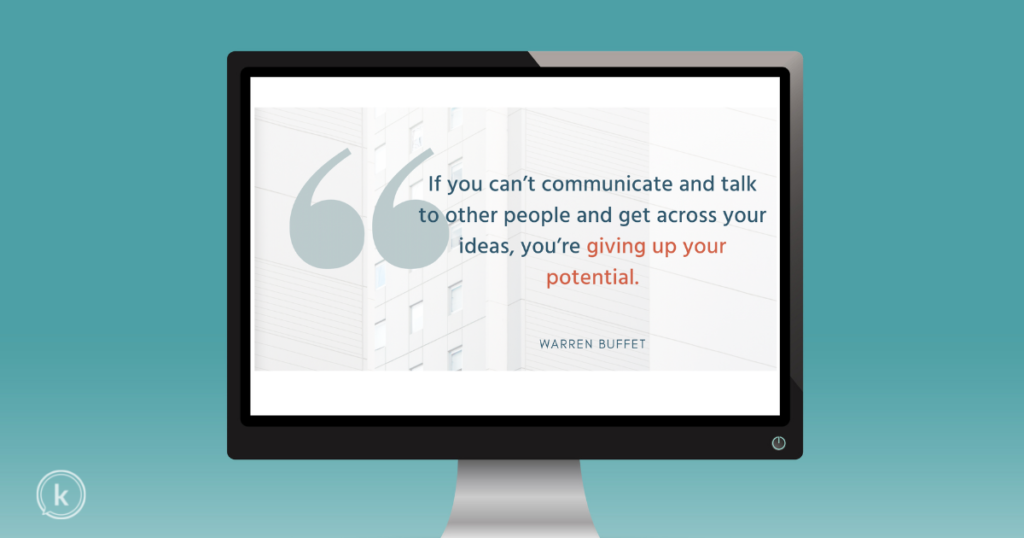Public speaking
How to know your audience (and why you should)
He just wanted to be done.
Kevin had spent weeks working on his presentation before working with me. I understood why he was anxious to wrap up the content development process and move on to crafting the deck and practicing delivering the presentation itself.
But it was imperative that we stop and think about his audience before moving forward.
Why it’s important to know and understand your audience for presentations—even ones you give often
Read MoreHow To Goldilocks Your Presentation Preparation
In recent weeks, I had two clients describe their presentation preparation process to me. Each represented one end of what we’ll call the “preparation spectrum.”
The first said, “I’m a manuscript speaker,” meaning that she writes out her message verbatim and uses that manuscript as her notes the day of the presentation (or memorizes it as written).
The other summed up his preparation saying: “I just jot a sticky note with three points and take that up with me and start talking… it’s more authentic that way.”
While there are benefits to both approaches, each carries pitfalls, too. Here’s what to know and how to find the sweet spot of preparedness that sets you up to deliver with confidence while still connecting with the audience.
Read MoreTop 3 pitch deck mistakes founders make—and how to avoid them
You have a great idea for a business venture.
The market is ripe.
You’ve sacrificed countless hours and dollars to bring it this far.
It’s time to secure funding.
And you’ve been given an opportunity to speak with would-be investors.
Would you wing it and just talk “off the cuff”?
Would you want to know if you were handicapping yourself with your deck or your presentation somehow?
Since 2018, I’ve been coaching entrepreneurs/founders through the public speaking aspect of preparing to pitch their ideas for funding. And I see the same mistakes again and again: entrepreneurs unnecessarily impeding the investors’ ability to see the merit of their idea. These are entirely preventable errors that are easily fixed, smoothing the path to successful fundraising efforts.
Read MoreThe four ingredients that make a good presentation great
Every presentation has a purpose. (Or at least it should. Ahem.) And that purpose is to move or change the audience’s way of thinking about your topic… to persuade them to approve your idea or incite action. To do that requires the presenter to have clarity about their intended message and to present their content in a structured way that makes it easy for the audience to understand.
Having a clear narrative structure is foundational to giving a good presentation.
But to give a great presentation or talk—one that’s truly engaging, effective, and memorable—requires the use of an emotional structure layered in atop that narrative structure. The emotional structure is comprised of four elements:
Read MoreThe painful (and sometimes funny) discovery of blind spots
When the irony fell on us all at the same moment, we dissolved into gales of laughter.
Fourteen of us sat around the conference room table in Chicago. It was an opportunity to gather with colleagues; most of us had never met in person.
On the first morning of our two-day confab, we encircled that table, sharing what we hoped to glean from our time together. I voiced my desire to identify blind spots in my role as a trainer and facilitator; that desire was written on the glass-covered pink wall alongside the hopes expressed by my cohort.
And then we dug into the work: learning, discussing, asking questions, practicing, and receiving feedback. It. Was. Awesome. I am a better trainer because of the insightful comments of my colleagues. Our day’s efforts were rewarded with a hearty meal and an evening outing. My night concluded in a smaller group, waxing philosophical in oversized chairs in the hotel lobby.
When I made it to my room around midnight, I fell into bed exhausted and wholly satisfied.
But sleep didn’t come quickly. My introverted nature got the better of me after a full day of activity. Like an overstimulated toddler who didn’t get to nap on time, my nervous system was in hyperdrive and I laid awake until after 3am.
Read MoreHow to share full-screen slides and use presenter view for speaker notes—from a single screen
In a recent workshop, one of my clients justified their extremely wordy slides with the fact that they don’t have a second screen to project from in order to use speaker notes in presenter view…so their slides had to be their notes. Maybe you can relate?
Maybe you’re working from home and a second screen won’t fit your workspace (or is too costly to acquire).
Maybe you’re working from somewhere else altogether and don’t port a second screen with you. (Hawaii, anyone? A girl can dream…)
Maybe you’re standing in front of a prospective client or investor in person and are connecting to their projector to present.
If you don’t have a second screen, but need to share your slides in a presentation, you likely either (1) generate a set of notes that you can view separately (printed or in another application) or (2) do as my client did: create slides that function as your notes.
While it’s the common choice, the latter is far from ideal: Your audience will disconnect from you to read your slides instead of listening. And you’ll seem slow compared to their reading speed. But that’s another post.
Creating a separate document for notes is a reasonable solution: they’re accessible during the presentation and, when printed, are easy to mark up with cues for parts you need to emphasize. But what if paper notes are inaccessible (or give an air of unpreparedness)? You’ll have to constantly switch applications between an electronic version of the notes and the slides in order to advance them.
There is a better answer.
Read MoreWhen you (really) should be on camera in virtual meetings
It was the final session of a week-long workshop. We’d crafted content. We’d prepped slides. Now we were practicing delivery. I pulsed the group: “What’s your biggest challenge presenting in the virtual setting?“
His answer: Presenting to people who aren’t on camera. Because it was such a drain on his energy.
The irony: Not only was this participant not on camera when he said it, he hadn’t been on camera all week. Not once.
Thankfully, I didn’t even have to point out the incongruity of his words with his actions. He owned it in his next sentence, saying he knew he needed to do better—for the sake of others—and flipped on his video.
We’ve all been on both sides of this equation:
- Utterly depleted from being on camera for so many meetings, day in and day out.
- Feeling challenged—maybe even frustrated—when we can’t see our colleagues during our presentation. (Have they left the building and are gallivanting around downtown Chicago? Bueller? Bueller?)
The impact of what’s becoming known as “self-presentation” is being documented with increasing regularity. It affects women and new hires disproportionately; we need to honor the need to be off camera for the sake of everyone’s mental health.
So what’s the answer for the presenter who doesn’t just appreciate a friendly face, but actually relies on the non-verbal communication of seeing their colleagues to know whether their message is being understood?
Here are my guidelines for being on (and off) camera for presenters and audiences, alike:
Read MoreThree quick and easy brain hacks for public speaking anxiety
In the moments leading up to giving a presentation or speech, many people feel a surge of anxiety—heart-racing, hand-quaking, sick-to-their-stomach anxiety. Some of the work to fortify oneself against the fear of public speaking happens well in advance of the actual presentation or speech. But when the adrenaline and cortisol flood your body right before you take the “stage,” you need an additional, entirely different set of tactics.
Read MoreHow to introduce a speaker (or how to write your own introduction)
If an event has a speaker, s/he will need to be introduced. At larger events, that’s often done by someone whose primary function is to act as MC; at smaller events, the event or meeting planner is likely to introduce the speaker in addition to all their other responsibilities. In either case, the content of that introduction would ideally be developed well in advance of the event.
MCs/event hosts will want to contact the speaker(s) for some raw information to use for crafting the speaker’s introduction. (This is especially important if the event host will be introducing more than one speaker, as the introductions should have some continuity in the content and style.)
When there’s no MC, the speaker him/herself will likely need to supply the introduction. This is often the case at smaller events and meetings (and podcasts!) where the planner has a myriad of responsibilities and might overlook it until quite late in the game or simply not know how to do it well.
Read MoreIf you write out your entire presentation, do this
Not everyone writes out the entire content of their presentation (or speech… or sermon…), but many people do. I always coach my clients to avoid doing so because it causes us to become too focused on word-for-word delivery—which isn’t helpful for either the speaker or the audience.
But there’s another reason it becomes a problem. If you’ve written out your content in full sentences, you’ve likely hampered your delivery (and the success of your message) without realizing it.
How?
Read More









